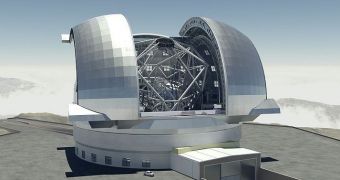The European Southern Observatory (ESO), the most prolific astronomical organization in the world, has finally decided on a final location to build its newest instrument, the European Extremely Large optical/infrared Telescope (E-ELT). The massive construction's main feature will be a whooping 42-meter-diameter primary mirror, which will ensure unprecedented observations power, even for a ground-based observatory. Once completed, the E-ELT will be the most massive instrument of its kind, and the “world's biggest eye on the sky,” according to European officials.
Finally selecting the construction site “is an important milestone that allows us to finalize the baseline design of this very ambitious project, which will vastly advance astronomical knowledge. I thank the site selection team for the tremendous work they have done over the past few years,” explains the Director General at ESO, Tim de Zeeuw. Competition for hosting the instrument has been stiff, particularly between Chile and Spain. The latter lobbied strongly at the European Union to be selected and even cited political reasons for it. But eventually, the Chile location won.
The E-ELT will therefore be built on Cerro Armazones, with a definite approval scheduled to be granted at the end of this year. If all formalities are met on time, the telescope should be operational by 2018. “In March 2010, the ESO Council was provided with a preliminary report with the main conclusions from the E-ELT Site Selection Advisory Committee. These conclusions confirmed that all the sites examined in the final shortlist (Armazones, Ventarrones, Tolonchar and Vizcachas in Chile, and La Palma in Spain) have very good conditions for astronomical observing, each one with its particular strengths,” ESO experts said in a statement.
“The technical report concluded that Cerro Armazones, near Paranal, stands out as the clearly preferred site, because it has the best balance of sky quality for all the factors considered and can be operated in an integrated fashion with ESO's Paranal Observatory. Cerro Armazones and Paranal share the same ideal conditions for astronomical observations. In particular, over 320 nights are clear per year,” they added.
“Adding the transformational scientific capabilities of the E-ELT to the already tremendously powerful integrated VLT observatory guarantees the long-term future of the Paranal as the most advanced optical/infrared observatory in the world and further strengthens ESO's position as the world-leading organization for ground-based astronomy,” de Zeeuw concludes.

 14 DAY TRIAL //
14 DAY TRIAL //